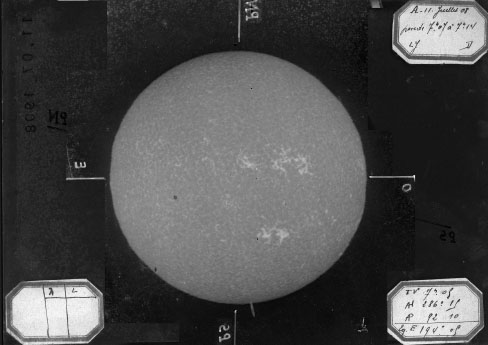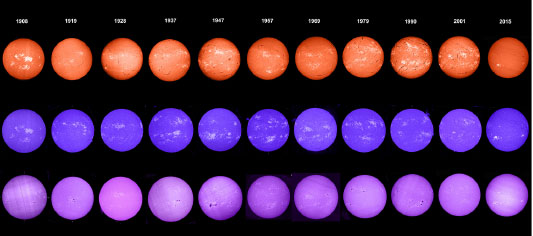Started in 1908, at the Meudon site of the Paris Observatory and interrupted only during the first world war, the systematic observations of the Sun constitute an exceptional set of over 120 000 photographs ; exceptional for its length, its quality and its duration, this is the most complete set of observations in the visible domain of the low solar atmosphere.

These observations have been carried out with the same instrument - the Meudon spectroheliograph - for 110 years.


The birth of the observations
Solar observations have always been a prime subject at the Paris Observatory. Several important dates :
In 1868 : Jules Janssen, one of the pioneers in French astrophysics, and a founder of the Meudon Observatory, discovered, thanks to spectroscopy, the element « Hélium » in the solar atmosphere at the same time as Lockyer during a solar eclipse.
In 1892 Deslandres, from the Paris Observatory, and Hale from the Kenwood Observatory at Chicago, take up independently a suggestion due to Janssen, and create independently an imaging system based on spectroscopic scanning, thereby enabling one to observe the solar atmosphere without a solar eclipse : thus was born the spectroheliograph.
In 1908* : Deslandres and his student Azambuja initiate the systematic observations of the Sun in the calcium spectral line.
In 1909 : While these kinds of observations had already started in 1904 at the Kodaikanal Observatory (India), the Paris Observatory was the first to realize these observations in the hydrogen Hα line.
Today
This scientific research activity, destined also for the good of society is carried out by the scientists at the Laboratoire d’études spatiales et d’instrumentation en astrophysique (LESIA - Laboratory for space studies and astrophysical instrumentation). It is part of the national research effort (services nationaux d’observations - SNO), recognized by the Institut National des Sciences de l’Univers (INSU) of the CNRS.
The observations and additional information on this work can be found on the new web site "observations-solaires".
Space meterology
Solar monitoring, part of the emerging domain of space meteorology, which tries to understand and foresee the state of the Sun in order to better foresee the perturbations incurred by our society which is increasingly reliant on space technology and on world-wide electric distribution network.
Systematic observations enable one to answer questions related to the probability of extreme solar eruptions, and hope to give future generations data enabling one to better understand how the Sun functions.
In effect, the Sun is a dynamic star in which occur regularly storms, the most violent phenomena in the solar system : billions of tons of magnetized solar matter are ejected into interplanetary space and affect regularly the terrestrial environment.
This leads to the creation of polar auroras, which are a product of solar eruptions.
Protected by the terrestrial magnetic field, there is no impact on the human race. It is nevertheless foreseeable that the world-wide society in which we live, increasingly reliant on technology, will become more and more sensitive to the effects of solar activity.
10 eleven year solar cycles
The activity of the Sun is not constant in time : our star has an 11year cycle, going from activity « maxima », the latest one dating from 2015, in which the eruptions are very frequent, to activity « minima » in which the eruptions are particularly rare during periods of months.

The systematic observations carried out at the Paris Observatory provide critical information on the evolution and the properties of the Sun during the various cycles.
Analyzing the data from past solar eruptions, the set of past observations enables one to compute the probability of extreme events : the super-eruptions.
This data also enables us to determine whether there are long period cycles – in particular the Gleissberg cycle which would have a period of 80 years, – over and above the well known 11 year cycle.
Only the observation of the Sun over very long periods of time, which cannot be done with the most modern satellite based observations, enable one to determine the characteristics of the solar activity cycles.
As with the measurements of ancient and contemporary temperatures measurements carried out at the meteorological stations and which are vital in order to understand the evolution of our climate, the systematic observations carried out by the Paris Observatory hope to play a critical role in the establishment of a "standard meter" for solar climatology.
A heritage for future generations
The continuing solar observations hope to provide future generations, in 100 or 200 years time, with a continuous and trustworthy record which will enable one to understand the exact functioning of the solar dynamo , which is responsible for the activity cycles with which our society has to learn to live.
